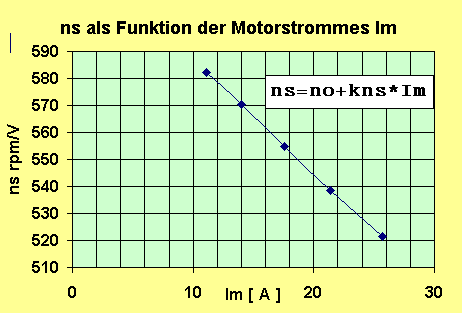|
| Um | Im | U | I | n | ns | no |
| kns | ||||||
| 5.63 | 8.89 | 5.31 | 7.19 | 3154 | 594 | |
| 6.53 | 11.15 | 6.12 | 9.45 | 3566 | 582 | |
| 7.61 | 13.99 | 7.11 | 12.29 | 4054 | 571 | |
| 8.85 | 17.55 | 8.22 | 15.85 | 4560 | 555 | 627 |
| 10.21 | 21.34 | 9.44 | 19.64 | 5083 | 538 | |
| 11.59 | 25.69 | 10.67 | 23.99 | 5563 | 522 | -4.09 |
We see in the table ns goes down when current goes up. This function is linear and represents some kind of magnetic stiffness. For this linear function we can find no (this is ns at Im=0) and kns - slope of the line. This two parameters are representing any given motor:
ns(Im) = no + kns * Im

From part of my Measurements can be seen, that no=ns(0) for one motor is absolutely constant, independent of big or small propeller has been rotated by the motor (motor stalled, or rotating without any proper load). The kns is constant also, at my LRK350-20 about -4.1.
But there is even more important regularity:
The product of no=ns(0) and windings number N is constant for any given LRK350 motor independent of windings and wire size.
|
|
Results:
1. For any stator, rotor combination independent of windings and load the characteristic value W exists. For LRK350-20
2. Having requested rpm/volt we can calculated windings count.
3. From windings count and wire size we can calculate inner resistance Ri.
The prove of this method can be found here.
Given: (e.g. LRK350-20-11)
Ri=15mOhm, no=820, kns=-4.2 und Io=2A
The inner resistance of the motor controller is: 4mOhm (2+2)
You want run this motor on 8 V with 35 Amp.
Question:
What is the revolution per minute rpm?
Solution:
Um = 8V than Uemk = Um - (Ri+Ric) * Im = 7.33V
ns at that current:
ns(35A) = no - kns * Im = 673 rpm/Volt
The rpm is:
n = ns * Uemk = 673 * 7.33 = 4,933 rpm
The mechanical output is (without magnetic losses)
Pmech = Uemk * (Im - Io) = 7.33 V * 33 A= 240 W
For the rpm and power you need an propeller with the 100 watts specific number n100w of:
( n / n100w ) ^ 3 = Pmech / 100
n100w ^3 = n ^3 * 100 / Pmech
n100w = 3685
back to LRK site